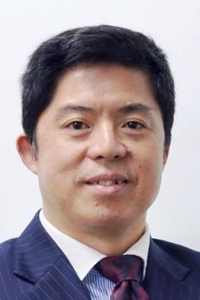发布时间:2021-04-28

姓名:邱顺添
职称:教授
系别:环境工程系
主要研究方向:水环境系统综合模拟;给排水管网规划与设计;智慧水务;城市水系统仿真与工程规划;算法优化与工具开发;公众水文学;水信息学
办公电话:022-87402075
电子邮箱:soon.thiam.khu@tju.edu.cn
教育及工作经历:
2019/08—至今,天津大学,环境学院,院长,教授,博士生导师
2015/08—2019/07,澳大利亚莫纳什大学双威校区,土木工程系主任,教授
2012/08—至今,中国环境科学院,外籍教授
2009/06—至今,北京大学,环境科学与工程学院,客座教授
2011/08—至今,中国水利水电科学研究院,客座教授
2010/02—2015/07,英国萨里大学,环境与健康工程中心主任,教授
2000/10—2010/06,英国埃克塞特大学,工程、计算与数学学院,高级讲师
2000/04—2000/09,荷兰代尔夫特技术大学,高级研究员
1998/07—2000/03,丹麦水利研究所,研究员
1994/07 - 1998/07, 新加坡国立大学,土木与环境工程,博士
1991 /07- 1994/07, 新加坡国立大学,土木工程,硕士
获奖情况:
2019 国家高层次引进人才
2012 英国皇家女皇科技教育奖
学术兼职:
国际水利协会水系统调度分会副主席
国家科技计划项目及国家人才评审专家
国家自然科学基金项目评审专家
天津市规划资源局专家
天津市人民政府重大行政决策咨询论证专家
“陆海统筹关键带国土空间规划与环境资源可持续利用工程技术创新中心”技术带头人
国际期刊 JAWRA、WEM、JFRM、JHER 等期刊副主编
主要研究成果:
城市智慧水系统工程平台项目的城市配水和排水系统优化成果受到广泛应用,同时制定了欧盟 H2020提案;可持续发展之河项目,自主开发的水环境改善的快速反馈模型作为ISIS-GIS 软件核心技术,拟创造 951.7 亿元商业价值;河口形态工程中泥沙输移模型率定研究,开发的“元胞自动机下遗传优化”优化算法成为 MIKE 软件中多目标水系统模型率定验证的关键模块,广泛应用于 30 个多个国家。
科研项目:
先后主持/参与过中国、英国基金委项目、欧盟项目,中英中欧双边项目以及各类横向课题等 42 项项目,经费总额约 5000 万人民币。代表性项目如:
1. 欧盟H2020,RECONECT: Regenerating ECOsystems with Nature-based solutions for hydro-meteorological risk reduction,2018/05- 2022/04,50万欧元;
2. “十三五”国家重点研发计划课题,高寒区供水渠道突发险情应急调度与抢险技术,2017/12-2021/12,304万元;
3. 莫纳什大学CRM2403,River of Sustainability,2017/12-2018/06,25万马来西亚林吉特;
4. 莫纳什大学AEP-17-016,multidisciplinary research competitive grant application year 2017-pump priming scheme,2017/06-2017/12 ,73680马来西亚林吉特;
5. “十三五”国家重点研发计划项目,长江上中游特大水利枢纽调控与安全运行技术研究,2016/07-2021/12,3000万;
6. 国家自然科学基金面上基金,快速城市化流域降雨径流污染季节变化的机理与不确定性,2011/01-2013/12,37万;
7. 欧盟FP6,New Approaches to Adaptive Water Management under Uncertainty,2005/01-2009/02,15118673欧元;
8. 英国工程与自然科学研究理事会,Multi-objective pipe network optimization: A holistic approach for design, upgrading and expansion,2002/10-2004/07,64155英镑;
代表性论文:
发表 SCI论文 200 余篇,其中水系统优化算法的代表性论文单篇他引率 510 次,部分代表作如下:
1. 公众水文学——理论框架.天津大学学报(自然科学与工程技术版), 2021, 54(10): 991-997.
2. 公众水文学——技术体系.天津大学学报(自然科学与工程技术版), 2021, 54(11): 1101-1110.
3. Effect of coagulation on bio-treatment of textile wastewater: Quantitative evaluation and application[J]. Journal of Cleaner Production, 2021(7):127798.
4. Simulation platform of human-environment systems for water environment carrying capacity research. J. Cleaner Production, 2020,250:119577.
5. Validation of the hypothesis on carrying capacity limits using the water environment carrying capacity. Sc. Total Env., 2019,665:774-784.
6. Modelling the combined effects of runoff reduction and increase in evaporatranspiration for green roofs with a storage layer. Ecological Engineering, 2019, 127:302-311.
7. Status and challenges of water pollution problems in China: learning from the European experience. Environ. Earth Sc., 2014,72:1243-1254.
8. Efficient Multi-Objective Optimal Design of Water Distribution Networks on a Budget of Simulations Using Hybrid Algorithms, Environm. Model. Softw., 2019,24(2):202–213.
9. Use of surrogate modelling for multiobjective optimisation of urban wastewater systems. Water Science and Technology, 2019,60(6): 1641-1647.
10. Incorporating multiple observations for distributed hydrologic model calibration: an approach using a multi-objective evolutionary algorithm and clustering. Adv. in Water Resour. 2008,07: 1387–1398.
11. Water quality Model Calibration under Unknown Demands. ASCE J. Water Res. Plng & Mgt. 2008,134(4):326-336.
12. An Investigation on Preference Ordering Ranking Scheme in Multiobjective Evolutionary Optimization, IEEE Trans. Evol. Computation, 2007,11(1):17-45.
13. Incorporating spatial and temporal information for urban drainage model calibration: an approach using Preference ordering genetic algorithm. Adv. in Water Resour. 2006,29(8).
14. From single-objective to multiple-objective multiple-rainfall events automatic calibration of urban storm water runoff models using genetic algorithms. Water Science and Technology, 2006,54(6-7): 57-64.
15. A novel evolutionary metaheuristic for the multi-objective optimisation of real-world water distribution networks, Engrg Opt., 2006,38(3):1-18.
16. Multiobjective calibration with Pareto preference ordering: An application to rainfall-runoff model calibration, Water Resour. Res., 205,41(3),
17. A novel cellular automata approach to optimal water distribution network design, J. Computing in Civil Engrg., ASCE, 2006,20(1):49-56.
18. A hybrid genetic algorithm for the design of water distribution networks, Engrg. Applications of Artificial Intelligence, 2005,18(4):461-472.
19. Reduction of Monte Carlo simulation runs for uncertainty estimation in hydrological models, Hydrol. Earth System Sc., 2003,7(5):680-692.
20. Genetic programming and its application in real-time flood forecasting. J. American Water Resources Assoc., 2001, 36(2):439- 452.
出版专著:
1. Proc. 8th International Conference on Computing and Control of the Water Industry: Water Management for the 21st Century. ISBN 0-9539140-2-X
2. Proc. ACTUI 2004: Decision Support in the Water Industry under Conditions of Uncertainty. ISBN: 09-539140-1-1.
3. 城市水问题新解译:荷兰水城的设计与管理, 科学出版社.
4. Applications of Evolutionary Computing in Hydrological Sciences. In Anderson, M.G., ed., Encyclopaedia of Hydrological Sciences: J. Wiley. 2005.
5. Many-Objective Evolutionary Optimisation, in Juan R. Rabuñal, Julián Dorado and Alejandro Pazos (eds),Encyclopaedia of Artificial Intelligence, Information Science Publisher. ISBN: 978-1-59904-849-9
6. Stochastic System Dynamics Integrative Model: An Integrated Modeling Framework Spanning Policy Domains Environmental Modeling for Sustainable Regional Development: System Approaches and Advanced Methods.
7. Research and Innovation Mapping Study for the UK Water Research and Innovation Framework. UKWIR Report Ref. No. 11/RG/10/6
授权发明专利:
1. 一种水利施工用管道内壁清理装置, 2021-1-12, CN202110038500.4
2. 一种阶段式农田硬质生态排水渠, 2019-8-6, ZL201910719733.3
3. 一种地下水质水量监测装置, 2021-1-12, CN202110038465.6
4. 一种土壤水质采样检测设备, 2021-1-12, CN202110037799.1
5. 一种水利工程用排淤装置, 2019-8-6, ZL201910719725.9
6. 一种街区式城市内涝防涝蓄水装置, 2021-08-06, CN113216062A.